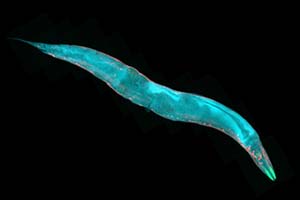
Introduction
C. elegans are particularly useful in the study of the aging processes because the organism passes through several distinct phases of life which can be observed physiologically and genetically using a dissecting microscope.
These organisms are a great model for studying genetics and biology. It’s small, reproduces quickly, and is easy to grow and maintain. Its transparency makes it easy to observe how genes and environmental changes affect development. Students will start by learning various research techniques using C. elegans and then work on a project to analyze a specific mutant strain. This approach provides hands-on experience with a versatile and cost-effective model organism.
Students will gain hands-on experience with a model eukaryotic organism. They will observe and study the life cycle of C. elegans. They will practice their microscope skills and learn how to subculture C. elegans. Additionally, they will explore how genetics affect behavior.
Grade Level: 11-12
Content Area: Biology, Science
About the Author
 Edwin Davis is a 2023-24 Kenan Fellow. He learned about using single-cell organisms during his summer industry immersion in the lab of Dr. Amy Maddox at UNC-Chapel Hill. During his internship, Davis attended weekly staff meetings, observed research updates from graduate students, and asked questions about various aspects of their research. Dr. Maddox’s graduate students provided him with valuable research information, guidance on lab procedures, and insights into how their work might contribute to understanding and potentially preventing human diseases.
Edwin Davis is a 2023-24 Kenan Fellow. He learned about using single-cell organisms during his summer industry immersion in the lab of Dr. Amy Maddox at UNC-Chapel Hill. During his internship, Davis attended weekly staff meetings, observed research updates from graduate students, and asked questions about various aspects of their research. Dr. Maddox’s graduate students provided him with valuable research information, guidance on lab procedures, and insights into how their work might contribute to understanding and potentially preventing human diseases.
In the Fall semester of 2023, Dr. Maddox visited Broughton High School to co-teach with Davis. Dr. Maddox reviewed the life cycle of C. elegans and demonstrated techniques such as “chucking” and transferring the worms to new agar plates.
Davis feels deeply grateful for his Kenan Fellows experience. His teaching goes beyond traditional academics, drawing from his unique experiences to enrich his curriculum. Through his work with Communities In Schools of Wake County, he helps reduce high school dropout rates by 39% for Black boys from low-income families by being a positive role model.
Download the lesson plan for a list of resources and additional details for implementation.
- Essential Questions
- Time Needed
- Standards
- Making Connections
- Background
- Materials
- The Activity
- Wrap and Action
- Resources
Essential Questions
The phylum Nematoda serves as an excellent model for exploring how development evolves, using a comparative approach to developmental genetics.
Why is C. elegans a great model to use in the study of human development and diseases?
Time Needed
Ideally, this curriculum unit would begin on a Monday or Tuesday so that students could make their 15-minute, 24-hour and 48-hour worm observations on three consecutive school days. If the schedule does not allow
for three consecutive days, the third observation can also be done at 72 hours.
Standards
NCES.K.L.1 – Compare characteristics of animals that make them alike and different from other animals and nonliving things.
NCES.2.L.1.2 – Compare life cycles of different animals such as, but not limited to, mealworms, ladybugs, crickets, guppies, or frogs.
Making Connections
Why choose C. elegans?
In addition to being a powerful system for genetic studies, C. elegans has many inherent advantages as a model for eukaryotic biology. These features include its small size, large brood size, ease of cultivation, low
maintenance expense, long-term cryopreservation, quick generation time, transparency, invariant cell number and development, and the ability to reduce gene activity using feeding RNAi. C. elegans are greatly aided by the transparency of the animal, which allows researchers to examine development and changes due to mutations or altered environments at the level of a single, identified cell within the context of the entire living organism.
Before students design their worm research projects, they learn and practice several research techniques with the model organism, Caenorhabditis elegans. This nematode is an ideal choice for experimentation in an Academic and Honors lab due to its powerful genetics,
ease and low cost of maintenance, and amenability for basic research training. Students are challenged to characterize an instructor-assigned “mystery mutant” C. elegans strain.
The “mystery mutant” strain has a defect in cholinergic synaptic transmission. Students are well poised to experimentally test how the mutation impacts synaptic transmission. For example, students design experiments that address questions: Does the affected gene influence acetylcholine neurotransmitter release? Does it inhibit postsynaptic cholinergic receptors?
Students must apply their understanding of the synapse while using their recently acquired research skills (including aldicarb and levamisole assays) to successfully design, execute and analyze their experiments. Students prepare an experimental plan and a timeline for proposed experiments. Students work collaboratively in pairs and share their research findings in oral and written formats.
Background
After distinguishing himself with major discoveries in molecular biology while at Oxford in the early 1960s, Sydney Brenner turned his attention to developmental biology. Working in Cambridge, he and his colleagues wondered how multicellular organisms develop. He looked for an animal that was simple but that had a nervous system and other distinct, differentiated
tissues, including the epidermis (skin), muscle, and intestine.
After careful research, he selected a microscopic roundworm called C. elegans. Although some roundworms are parasitic, C. elegans is free-living. These worms grow quickly—from embryo to adult in 3 days—are easy to culture and can be stored in a freezer.
The embryos, larvae, and adults are transparent, making observations of morphology and development in living worms easy. C. elegans worms have 2 sexes: self-fertile hermaphrodite and male. Males are rare in wild-type populations, but they allow for genetic crosses.
However, because the hermaphrodites are self-fertile, most strains can be maintained without time- consuming crosses. Remarkably, almost every cell division during development is invariant, occurring the same way in every worm. Isolating genes and introducing foreign DNA are much easier in worms than in more complicated animals. All of these features make C. elegans an excellent model for research on how cells divide, develop, and take on specialized tasks in higher (eukaryotic) organisms.
Brenner and John Sulston showed that C. elegans also has a small, compact genome, which proved to be especially important once large-scale sequencing became possible. The C. elegans genome, which is approximately 1/30th the size of the human genome, was the first genome of a multicellular organism to be entirely sequenced. Once the human genome was
also completed, it became clear that 40% of C. elegans genes have human matches, and that despite their difference in size, both the human and C. elegans genomes contain approximately 25,000 genes.
In 2002, Sydney Brenner, John Sulston, and Robert Horvitz were awarded the Nobel Prize for their pioneering work on C. elegans and the discovery of genes that control cell death. In humans, these same genes are often mutated in cancer cells. Other C. elegans researchers have made numerous important discoveries, including those for genes controlling aging,
obesity, diabetes, and developmental patterning. They have also made important discoveries in cell biology and neurobiology.
Materials
- 30 OP50-Seeded NGM-lite Plates
- 2 BLI-1 Mutant C. elegans
- 2 DPY-11 Mutant C. elegans
- 2 Wildtype (N2) C. elegans
- 8 Spatulas
- 1 Bunsen Burner
- 1 Stereomicroscope with Transillumination (minimum 30x)
- 1 Beaker with 95% Ethanol Incubator
- Thermometers
- Paper towels
- Distilled water
The Activity
Part 1: Introduction
Caenorhabditis elegans as a model organism.
- Students learn about the organism’s life cycle.
- Students prepare media for C. elegans culture.
- Students prepare the incubator, set the incubator temperature, and pour media plates for C. elegans.
C. elegans developmental timing is temperature sensitive. At higher temperatures, development will proceed faster, making timing difficult to predict. You may want to test the timing for your conditions by chunking one plate of wild-type worms before carrying
out the activity. Ensure that the worms are kept at temperatures ranging from +11°C to +20°C.
Brief periods above or below this temperature are tolerated but not ideal. Long periods outside this temperature range can kill or sterilize C. elegans. Note that Part II and Part III can be carried out on the same day or separate days. If more than one day has
passed between Parts II and Part III, chunk wild-type worms to at least one of the extra included plates to provide students with a control.
Part 2: Preparation
Preparation of bacterial food source & NGM petri plates for C. elegans.
Students learn the ‘chucking’ method of transferring C. elegans onto a culture plate with E. coli.
Students transferred C. elegans onto new plates.
“Chunking” is a way to keep worms alive and maintain growth. Cut a 1 cm square “chunk” of agar with worms in it from a plate with growing worms. Use a sterile scalpel dipped in alcohol and flamed before and after each use – Transfer “chunk” to the new seeded plate.
Use this technique when you don’t care exactly how many worms are transferred to the plate.
Wrap and Action
As a follow-up, students will be able to perform the following tasks:
- Get hands-on experience with a model eukaryotic organism.
- Observe and study the life cycle of C. elegans.
- Utilize their microscope skills.
- Learn how to subculture C. elegans.
- Learn about genetics and its effect on behavior.
Experimental Technique Assessment
- Students will be able to use experimental nematodes such as C. elegans cultured in the laboratory on 6 cm Petri plates containing Nematode Growth Medium (NGM). Students will be assessed on their technique of transferring C. elegans to new culture
plates. C. elegans worms are typically kept at 20°C; but can be incubated at a range of temperatures (between 4°C – 25°C), depending on the nematode species and experimental design. - Students will be assessed on their “Chucking” technique. Students must use the “Chucking,” technique to transfer C. elegans worms to culture plates. A quick and convenient method is “chunking”, wherein a sterilized scalpel or spatula is used to move a chunk of agar from an old plate to a fresh plate. The worms will crawl out of the chunk and spread out onto the bacterial lawn of the new plate.
- Students will be assessed on their ability to identify the various stages of C. elegans on an agar plate using a dissecting microscope.
- Students will perform a statistical grid count to determine the number of C. elegans adults needed for the experiment.
Resources
Download the lesson plan for a list of resources and additional details for implementation.